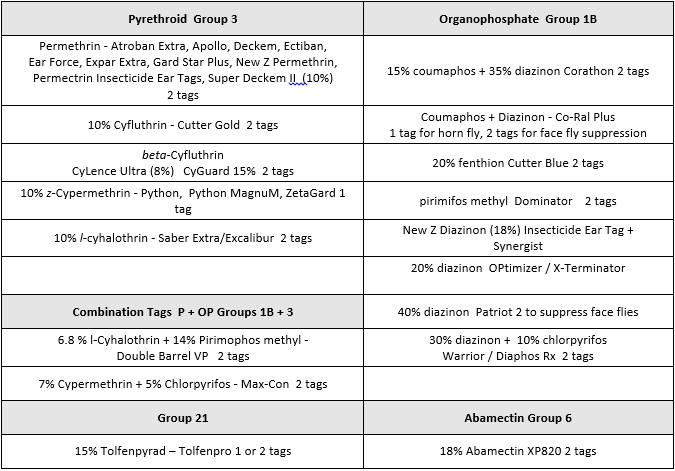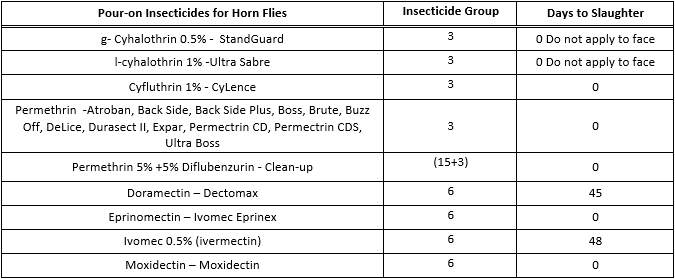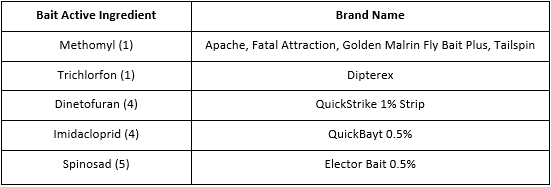Insect Control for Beef Cattle - 2016
ENT-11: Insect Control for Beef Cattle - 2016 | Download PDF
Prepared by Lee Townsend, Extension Entomologist
University of Kentucky College of Agriculture
This publication contains only a portion of the important information included on pesticide labels. Always read the product label carefully before buying and using any pesticide. Also, pesticide labels and registrations may change at any time. Any statements in this publication that disagree with the label must be disregarded. Many insecticides are sold under brand names that are not listed in this publication. No endorsement is intended for products mentioned, nor is criticism meant for products not listed. Products listed in bold are Restricted Use insecticides. Products listed in italics are approved for organic production.
Insecticide Groups
Insecticides have been placed into numbered Insecticide Groups (1 – 28) based on how they work against insects. Continual use of products from a single Group against a pest species can lead to reduced control (resistance) by all products in the Group. In order to minimize control failures due to insecticide resistance, do not apply insecticides within the same group repeatedly, even when using different application methods (baits, residual sprays, knockdown sprays, etc.). Rotate among groups during the fly season. For example, for house fly control, alternate between Group 1 and Group 3 for residual sprays and use a fly bait from Group 4.
Pasture flies – Horn flies and Face flies
Horn fly control can mean an additional 12 to 20 pounds of weight gain per calf over the summer months and reduced weight loss for nursing cows. Horn fly numbers can be kept below the target level of less than 100 fly per side (200 per head) by a variety of methods. Consider cost, convenience, physical layout, and rotational grazing plans when selecting a control program.
There is no clear information on the number of face flies per head that lead to economic loss. These flies are very annoying but even heavy infestations do not seem to reduce the rate of weight gain. These flies can disrupt grazing during the day but cattle will compensate by grazing at night. Face flies can spread pinkeye spread from animal to animal in a herd but outbreaks occur even when face fly numbers are low. Control measures should be increased if the incidence of pinkeye has been high.
Application methods – Pasture flies
Dust bags are most effective in forced-use situations where cattle have to pass under them regularly as they move to drink or eat. The bottom of the bag should be low (about 18” above the ground) so that the animal must lift it with its head to pass through. This provides good insecticide placement to manage face flies. The animal is treated for horn flies and other biting flies as the bag drags along the backline.
Keep dust bags charged with insecticide and protected from rain. Dust formulations will clump if they get wet and will not dispense the insecticide properly. See Entfact 515 "Dustbags for Cattle Insect Control" for more information on forced-use dustbags.

Insecticide Impregnated Ear Tags (number of tags per animal)
Insecticide ear tags can provide good control of horn flies and may provide some reduction in face fly numbers. Install tags after flies first appear in the spring Horn fly resistance to insecticides is an increasing problem. If insecticide resistance is suspected, use tags containing an insecticide with a different Group number. Remove tags at the end of the fly season (September) or before slaughter. Protective gloves should be worn when applying or removing tags. In general, calves less than 3 months old should not be tagged because ear damage may occur.

Backrubbers / Oilers

Use diesel or No. 2 oil, or label-recommended mineral oil to dilute concentrate. Do not use waste oil or motor oil. One gallon of oil solution per 15 to 20 ft of back-rubber cable is sufficient for 30 to 40 head. Do not use these dilutions as sprays. As with dust bags, these devices are most effective when placed in force-used areas such as mineral stations or entrances to watering sites. Rubbers are more effective against face flies if fly flyps or fly bullets are tied at four to six inch intervals along the length. Service the devices at least once per week and position in entryways to water or mineral feeders. For more information on back-rubbers see ENT 4 "Making and Using a Cattle Back-rubber" available from your county extension office.
Pour-on Insecticides

Animal sprays
Use a power sprayer for complete coverage when applying insecticide sprays for pasture fly control. Do not contaminate feed or water.

Alternative treatment options
Compressed air gun (Smart Vet/Vet Gun) used to dose animals with Aim Capsules containing l-cyhalothrin. One cap per animal over 600 lbs provides approximately 3 weeks of horn fly control.
Feed additives target fly maggots breeding in fresh animal manure. Results can be very variable. All animals must eat a minimal dose of a feed additive regularly. Supplementary control measures must be taken to deal with flies moving in from nearby herds.
Methoprene, an insect growth regulator (IGR), is available in Altosid Block, Tub, and Liquid products for horn fly control.
The organophosphate insecticide Rabon (stirofos) is available as a 7.76% Premix for horn fly and face fly control.
Clarifly (diflubenzuron) is available in several premix forms for horn fly and face fly control.
Insecticide bolus Vigilante (9.7% diflubenzuron) is a large pill-like formulation that is given with a standard balling gun. For best results, the entire herd should be treated.) The active ingredient, an insect growth regulator, is gradually released from the bolus and prevents development of horn fly and face fly larvae in manure.
Chewing and Sucking Cattle Lice
Problems with cattle lice can be kept to a minimum by the following procedure: Treat all animals in the herd with approved pour-on, spot-on, or spray-type chemicals. This treatment will kill all active forms but will not kill the eggs. Retreat the entire herd 10 to 14 days later, to kill any newly hatched lice. This should eliminate lice on the herd. Reduce the chances of re-infestation by keeping all new animals isolated from the herd until they have been treated twice. Maintain fencing so that cattle do not mix or come in contact with neighboring herds.

Systemic insecticides The systemic pour-on and injectable insecticides for cattle grub control will also control or suppress sucking and or biting lice. See the cattle grub control table for specific products.
Sprays In addition to the sprays previously listed for horn fly and face fly control, Co-Ral, Prolate/Lintox-HD (1 qt in 38 gal of water), Rabon 50WP (2 lbs / 25 gal of water), or TactiK (amitraz) 12.5% EC (8 fl oz per 25 gallons of water) will control cattle lice. Use Tactik within 6 hours of mixing.
Cattle Grubs
Cattle grub treatments must be properly timed in order to be effective and to minimize risk to animals. Make applications as soon as heel fly activity ceases, usually by August 1. Do not treat after October 31, preferably not after October 15. Cattle grub treatments applied as pour-ons, spot-ons, injections, or sprays are systemic insecticides which travel within the animal's bloodstream. Treatments applied too late may cause toxic reactions and must be avoided. When using Ivermectin in the fall worming, there is no need to use another insecticide for cattle grub control. Do not treat calves less than 3 months old or cattle under stress from illness, shipping, castration, dehorning, etc.

Other Pests
Horse flies Although Ectiban 5.7% EC is labeled for horse fly control at the rate of 1 qt per 100 gallons of water, it will only provide temporary relief, not long term control. There are no practical control methods for these insects on pastured animals. Animals with access to sheds or barns can escape attack.
Ticks occasionally can be a problem on beef cattle grazing in over-grown areas. Many pasture fly sprays and pour-on products will control ticks. See product labels for directions. Use Rabon 50 WP at 2 lbs per 25 gallons of water. Use Ravap at 1 gal per 200 gallons of water.
Mites Ivomec Pour On or Ivomec 1% Injection may be administered for mange mite control. See the label for dose rates. Ivomec Pour On has a 48 day slaughter interval, there is a 49 day waiting interval for the Ivomec 1% Injection. Eprinex is labeled for control of chorioptic and sarcoptic mange mites with no slaughter interval. Cydectin is labeled for psoroptic and chorioptic mange. Dectomax Pour-On is labeled for chorioptic and sarcoptic mange. Prolate/Lintox 11.75% EC (1 qt per 25 gallons of water) can be applied as a spray. Co-Ral Flowable Insecticide is labeled for control of psoroptic mange at 1 gal / 165 gallons of water.
Wound maggots Some flies (green flies) will deposit eggs on wounds or cuts and the maggots will develop in decaying flesh. Catron IV (permethrin) can be used to protect wounds on dairy cattle. Use as directed.
Fly Control in and around Beef Barns and Feedlots
Sanitation is the key step in reducing fly numbers around barns and confinement areas. Breeding sites include wet manure, straw, decaying feed, and all combinations. Keep areas around cattle pens, feed bunks and silos well drained. Insecticide treatments will work better when used in conjunction with an ongoing sanitation program to eliminate breeding sites. Immediate spreading of manure will reduce fly development or manure piles can be covered with black plastic.
Residual Fly Sprays
Insecticides may be applied as residual surface sprays, non-residual space sprays, baits, manure sprays, or feed additives. Always read and follow label instructions before applying insecticides for fly control. Treat walls, ceilings, posts, and other fly resting sites. Spray these areas thoroughly and to the point of runoff. In order to minimize control failures due to insecticide resistance, do not apply products containing the same active ingredient, or insecticides from the same chemical class, repeatedly throughout an entire season. See product labels for use rates. Rotation of pyrethroid and organophosphate insecticides can reduce the potential for development of resistance.

Do not contaminate food, water or utensils with spray. Do not treat animals directly. One gallon of spray treats 500-1,000 square feet, depending on the type of surface (See label directions). Apply to walls, ceilings and other fly resting sites. Alternate applications of pyrethroid insecticides and organophosphates. Residual fly spray materials listed above provide control for 1-7 weeks depending on fly infestation, weather, and surfaces treated.
Contact sprays, fogs, or spaces sprays provide rapid but short-term control of flies present during treatment. Repeat as needed. Do not contaminate feed or water. Animals may be present during application but do not apply space sprays directly to livestock. In order to minimize control failures due to insecticide resistance, do not apply the same insecticide, or insecticide within the same chemical class (particularly pyrethroids), repeatedly throughout an entire season. It is best to alternate applications of pyrethroids (permethrin, pyrethrins) with organophosphates (dichlorvos) to reduce the potential for insecticide resistance. See the label for use rates.

Fly Traps Large numbers of flies can be caught in baited fly traps but the traps may not do not cause any significant reduction in total fly numbers. In addition, this approach does not thing to eliminate fly breeding sites. Electrocuting light traps may reduce house fly and stable fly numbers in closed buildings.
Fly baits can be scattered where house flies congregate to provide some temporary reduction in numbers. Never use baits where cattle or other domestic livestock can eat them. Place baits in areas where flies congregate, such as window sills or doorways. Baits alone will not control fly populations. They should be used along with sanitation and other insecticidal methods (e.g., residual and space sprays).

Feed / Mineral - Rabon 7.76% Larvicide Premix, blocks and mineral feeds may be used for fly control. See the label for rates. Clarifly 0.67% Premix larvicides can be used for fly control. With either treatment, all animals most consume the minimal daily amount for manure to contain an adequate level of the active ingredient to kill fly maggots. S-methoprene IGR (Altosid) can be used for fly control in a variety of forms.
Manure sprays kill fly larvae that are developing in treated areas. They are recommended where manure cannot be removed on a 7 to 10 day schedule. Apply at a rate of approximately 1 gal/100 sq. ft. to kill maggots. Do not spread treated manure onto crops not listed on the insecticide label. Apply sprays at rates that wet the manure surface, it is not necessary to soak the manure. Repeat treatments as necessary but no more often than every 7 days. Rates to use in per 25 gallons of water include: 1 qt Larvadex 5% SC (cyromazine); 4 lbs Rabon 50% WP or 1 gal 24% EC; 1 gal Ravap 28.7% EC, or 1qt Vapona Concentrate.
Fly Parasite Release Programs
Several commercial firms offer a fly parasite release program that can be used to supplement fly control around concentrated livestock operations. These small wasp parasites attack house flies or stable flies. The benefits of parasite release programs in livestock operations have not yet been proven. Several parasite species are available. Spalangia nigroaenea attacks house flies and stable flies in feedlots. Parasites in the genus Muscidifurax attack house flies while those in the genus Spalangia attack stable flies. Do not buy blends of unknown species and do not buy shipments of Nasonia vitripennis, a species that has been ineffective in midwestern feed lots. See ENTFACT 502- "Biological Control of Flies".
Educational programs of the Kentucky Cooperative Extension Service serve all people regardless of race, color, age, sex, religion, disability, or national origin.
Issued in furtherance of Cooperative Extension work, Acts of May 8 and June 30, 1914, In cooperation with the U.S. Department of Agriculture. Nancy Cox, Director of Cooperative Extension Service, University of Kentucky College of Agriculture, Lexington, and Kentucky State University, Frankfort.
Revised annually — 12/2015
